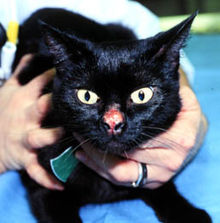Eosinophilic Granuloma Complex
A group of clinical symptoms in the area of the skin and / or the oral cavity is summarized under the name eosinophilic granuloma complex in domestic cats . It is therefore not a disease in its own right, but rather typical rashes that can have various causes. Eosinophilic plaques , collagenolytic granuloma , indolent ulcer and, more recently, miliary dermatitis are included in this complex .
Eosinophil plaque
Eosinophilic plaques are raised, round or oval, reddened , oozing, and ulcerated skin lesions. They mainly occur on the abdomen, the inside of the hind legs and the anal region. The plaques are very itchy, so they are licked intensely.
The cause of the formation of eosinophilic plaques is assumed to be the licking itself, as this only occurs in places where cats can reach with their tongues. The main triggering factors are allergies ( food allergy , flea allergy , atopic dermatitis ). The resulting skin changes become infected with bacteria and are characterized by an immigration of eosinophilic granulocytes . The diagnosis can be made by means of a contact specimen in which numerous eosinophils and bacteria can be detected microscopically. Treatment depends on the cause. The administration of amoxicillin and clavulanic acid has proven to be the best monotherapy .
Collagenolytic granuloma
The collagenolytic granuloma , also linear or eosinophilic granuloma , is a striped, yellowish-reddish and raised skin hardening that occurs mainly on the hind legs. Less common manifestations are the mouth region and oral cavity, the auricle and the paws. The collagenolytic granuloma occurs mainly in young animals. It shows no further symptoms, hair loss does not primarily occur. In the case of ulcerative changes, collagen is secreted in the form of small whitish crumbs, it can become infected and then cause itching. As with eosinophilic plaque, numerous eosinophils can be detected cytologically.
Causes are also all forms of allergy, but mosquito bites, genetic factors, foreign body reactions and virus infections are also discussed as possible triggers. The collagenolytic granuloma of the oral cavity develops without an apparent cause ( idiopathy ).
The collagenolytic granuloma can disappear spontaneously. Therapy depends on the cause. In the case of allergic reactions, desensitization or allergen avoidance can be attempted. Glucocorticoids , PLR 120 and ciclosporin are also used. Mosquito can repellents apply. Stubborn and recurring collagenolytic granulomas can also be treated surgically, with radio or laser therapy .
Indolent ulcer
The indolent ulcer ("pain-free ulcer") is a sore, slightly oozing and crusty change at the level of the canine . The cause is believed to be traumatic irritation of the lip by the canine tooth and / or tongue, which leads to a secondary bacterial infection. The indolent ulcer can usually be treated well with antibiotics , whereby the administration of amoxicillin and clavulanic acid has proven to be the most effective.
A nodular, hardened swelling of the upper lip, which can also change into an ulcer in the further course, is now assigned to the collagenolytic granuloma.
Miliary dermatitis
The miliary dermatitis is characterized by milletseeds nodules and crusts skin reaction. It can occur with all allergies, but also with skin fungal diseases and infestation with mites and fleas . In the case of miliary dermatitis, it is essential to clarify the cause and to choose the therapy accordingly.
literature
- Ch. Noli and F. Scarampella: Complex of eosinophilic granuloma and miliary dermatitis . In: Practical Dermatology in Dogs and Cats . Schlütersche Verlagsanstalt, 2nd edition 2005, pp. 353–357. ISBN 3-87706-713-1
- Julia Küpper and Ursula Mayer: The eosinophilic granuloma of the cat . In: Fachpraxis 35 (2011), No. 60, pp. 4–7.
Individual evidence
- ↑ a b B.C. Wildermuth et al .: Response of feline eosinophilic plaques and lip ulcers to amoxicillin trihydrate-clavulanate potassium therapy: A randomized, double-blind and placebo-controlled prospective study. In: Vet. Dermatol. 23 (2012), pp. 110-118.


